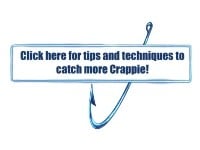Spider riggers like Hughey are one-of-a-kind angler able to juggle multiple rods, set a hook, net a fish, bait up a hook and run the trolling motor all at once. It’s in their DNA and they make it look all so easy; in addition to catching lots of crappie, big crappie.
Hughey takes spider rigging to another level by adding live sonar viewing to the mix. I’m guessing he played lots of video games when growing up. Like other prominent spider riggers, Hughey breaks down spider rigging into pre-fishing, fishing and cleaning.
For Hughey pre-fishing consist of getting his fishing tackle ready, checking rigging on the boat and buying minnows. Out of these 3 things, Hughey spends the most time on getting his tackle ready. One of the easiest things is rigging rods as he only has to change the fishing line on poles when needed. Buying minnows and keeping them alive isn’t hard with his live bait setup consisting of pre-built rigs and some that Hughey builds himself. For minnows Hughey normally purchases them at a local tackle shop.
“The rigs I use are either Capps and Coleman Minnow Rigs (bnmpoles.com) pre-built minnow rigs or some I hand tie using PICO Lures Vanguard Tackle (PICOLures.com) terminal tackle along with the PICO Lures Vanguard Tackle 10 pound test Forceflex Monofilament line,” Hughey continued, “The B’n’M Poles Capps and Coleman Minnow Rigs are easy to use since they are pre-made and ready to fish.”
B’n’M Poles Capps and Coleman Minnow Rig come 6 to a pack and wrapped around a spool ready to use. Each rig has a #2 bronze hook that’s perfect for maximizing bait action along with reducing snags during a day of fishing. The Capps and Coleman Minnow Rig is available in 1/4-, 3/8-, 1/2-, 3/4- or 1-ounce.
“Typically, I will try to tie up a bunch of homemade minnow rigs all at once. I know sooner or later I’m going to snag and break one. During the spring or winter months I tie a PICO Vanguard Tackle (picolures.com/) 1/2-ounce egg sinker with a minnow rig because I’m usually fishing slower and don’t need a heavier weight to keep the minnow rig vertical,” Hughey continued, “I will change to a PICO Vanguard Tackle 1-ounce egg sinker in the summertime allowing me to keep the minnow rig vertical even when moving at a faster speed or in deeper water.”
His homemade minnow rig is similar to the pre-built minnow rig. “I use PICO Vanguard Tackle size 7 two way swivels, gold size 2 Aberdeen crappie hooks and 10-pound test Forceflex monofilament fishing line,” Hughey went on, “Instead of the gold Aberdeen crappie hooks, I will also use a size 1/16- or 1/32-ounce PICO Scope Eye Jighead and rig a PICO soft plastic tube in a red/white, pink/white or yellow/white, but I will change to a black/chartreuse in muddy water. The tube gives the minnow a larger profile and different look that the larger crappie seem to like better. “
Where Hughey fishes depends on the time of year and where he has caught the crappie before. Typically, he will fish in the larger feeder creeks in the winter or post spawn then changing locations to the main lake in the summer months. What depth he keeps the minnow rig in depends on where the crappie are located. He noted that crappie will move up and down in the water column so an angler has to adjust the depth accordingly.
Although Hughey uses live sonar now he emphasized that any angler can spider rig, but having sonar and GPS/mapping can make finding and staying on crappie easier. “I constantly scan the area out in front of the boat searching for crappie to catch. I can even target the larger crappie if I want to with live sonar. Once I see one, I will move the boat forward putting the minnow right in its face,” Hughey went on, “It’s like one poling, but you have eight 16-foot B’n’M Poles Buck’s Graphite Jig Pole aka BGJP poles.”
Another thing Hughey emphasized was moving slowly when spider rigging although there are special conditions where he will move quicker. “I always like to move the bow of the boat into the wind allowing me to control the boat’s speed which I like to keep around .2- or .3-mph,” Hughey continued, “I don’t have Power-pole paddles or boat brakes, but the wind and trolling motor allow me to move slowly.”
The bow of Hughey’s boat has 8 single position rod holders he can adjust similar to the Driftmaster (Driftmasterrodholders.com) Crappie Stalker, crappie Stalker Pro or Crappie Stalker Max. Driftmaster’s adjustable single pole systems allow anglers to move the rod angle independently. Another option for rod holders is Driftmaster’s rod systems that can hold two or more rod holders at different angles. Hughey uses Driftmaster Rod Holders Tip Savers for storing and keeping his lines tangle free when going to the lake or moving from one fishing spot to another.




 Articles and Stories
Articles and Stories

















vBulletin Message